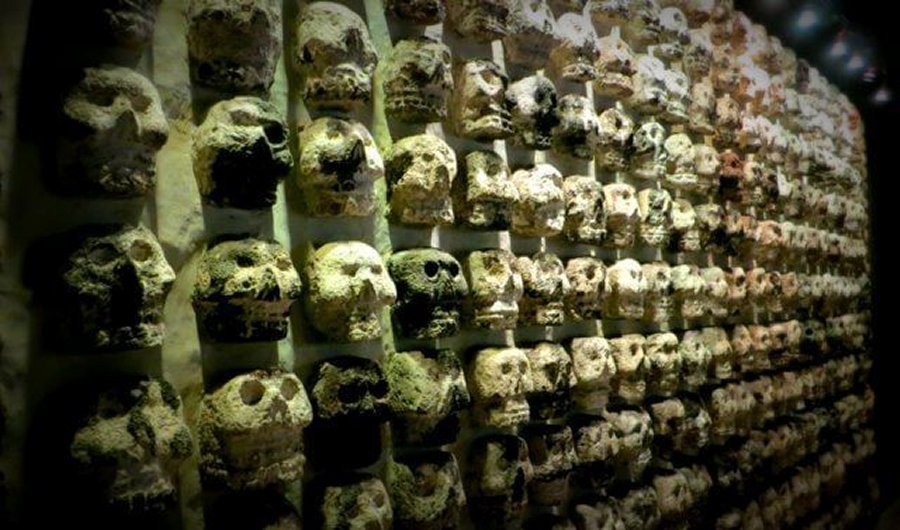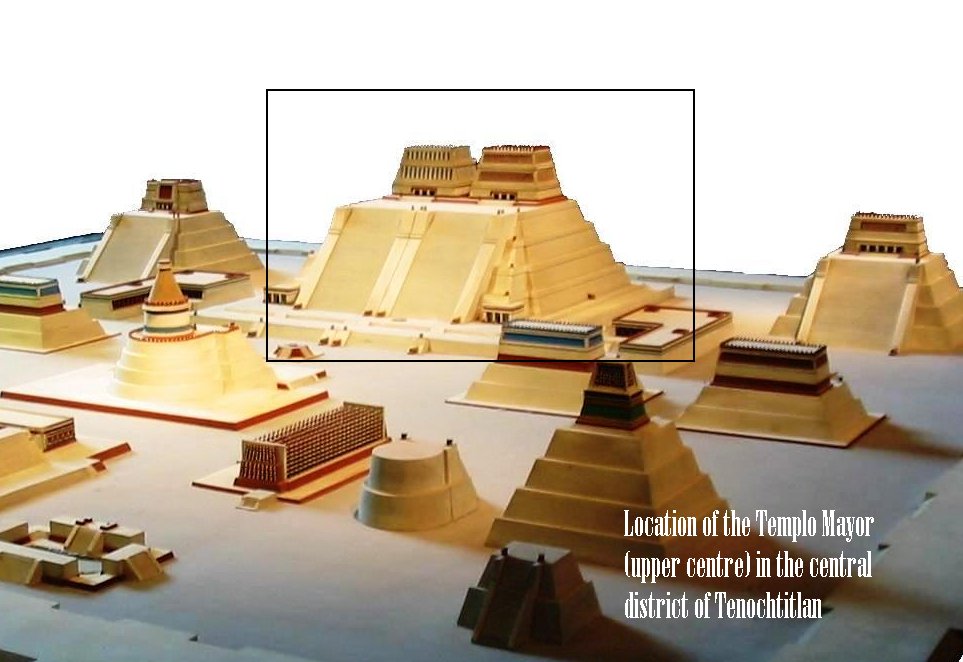Templo Mayor – Sacred Aztec Complex Dedicated To Gods Tlaloc And Huitzilopochtli Who Were Usually Appeased With Human Sacrifices
A. Sutherland - AncientPages.com - Most important sacred temple complex of the Aztecs - the Main Temple (in Spanish: Templo Mayor) was built in the center of the Aztec capital Tenochtitlán.
According to Aztec chronicles, the first temple (later followed by its twin temple) was built after 1325 and enlarged several times over the course of the 14th and 15th centuries.
Wall of skull’s. Image: Museo del Templo Mayor
The twin temples were dedicated to god of rain and fertility, Tlaloc ("the one who makes sprout") and Huitzilopochtli, god of war and sun.
Aztec chronicles confirm that both gods were frequently appeased with human sacrifices and other public rituals that took place in the temple.
Templo Mayor was shaped like a pyramid and its ruins are still in the city of Mexico. These temples, about 60 m (180 ft) above the level of the square at the foot of the pyramid, After conquering the city in 1521, the Spaniards almost completely destroyed the temple complex as a symbol of pagan worship.
In 1978, a carved, circular Aztec stone, depicting the mythical being Coyolxauhqui dismembered and decapitated, was accidentally discovered in the ruins of the Templo Mayor of Tenochtitlan, now in Mexico City.
The discovery prompted excavations at the site, which revealed the remains of superimposed temples forming the most sacred place in Tenochtitlán, during the greatness of the Aztec Empire – Temple Mayor.
It has been unearthed sacrificial deposits and offerings containing more than 7,000 different objects related to the site, such like clay pots depicting god Tlaloc, skeletons of turtles, frogs, crocodiles, and fish, snail shells, coral, some gold, alabaster, Mixtec figurines, ceramic urns, effigies, masks, copper rattles, decorated skulls and obsidian knives used during sacrifices.
Tlaloc god of rain, earthly fertility, water who could send thunder, hail, lightning. Image credit: Museo del Templo Mayor
To the Aztecs, death was the continuation of creation, and gods and humans alike had the responsibility of sacrificing themselves in order to allow life to continue.
Many cultures sacrificed people to their gods, also throughout Mesoamerica, but the Aztecs were infamous for their sacrificial rituals.
Depiction of a ‘tzompantli’ ("skull rack"), right half of image; associated with the depiction of Aztec temple dedicated to the deity Huitzilopochtli. From the 1587 Aztec manuscript, the Codex Tovar. Image: via Wikipedia
It was important to keep these important gods in a good mood. Tlaloc gave rain, which was crucial for agricultural activities but he also could send disastrous floods, storms and droughts. Huitzilopochtli, the supreme god and patron of Tenochtitlan, was also an important figure.
Offerings in form of flowers, food, golden objects were not good enough, to earn the gods’ favor.
Therefore, during specific holidays according to the Aztec calendar, bloody human sacrifices were offered to appease the gods and guarantee the prosperity of the Aztec society.
Sacrificial victims (mostly prisoners of war, but also children) were tied face up to a special stone before being killed with an obsidian knife. After sacrifice, the priests sprinkled the statues of the gods with blood and threw the hearts into a stone bowl with drainage channels. The body of the victim would be thrown down the staircase of the temple.
Templo Mayor complex also contained other, smaller buildings, platforms and ramps surrounding the main pyramid. The entrance leading to the top of the main pyramid was decorated with ‘tzompantli’, wooden scaffolding on which skulls of previously made victims were put - prisoners, slaves, children, as well as losers in a ritual ball game.
Written by – A. Sutherland AncientPages.com Staff Writer
Copyright © AncientPages.com All rights reserved. This material may not be published, broadcast, rewritten or redistributed in whole or part without the express written permission of AncientPages.com
Expand for referencesReferences:
José Luis de Rojas, Tenochtitlan: Capital of the Aztec Empire
Eduardo Matos Moctezuma E. M. Life and Death in the Templo Mayor
More From Ancient Pages
-
 Female Demon-Like Spirits That Can Lure Men Into A Deadly Circle Dance
Featured Stories | Apr 17, 2025
Female Demon-Like Spirits That Can Lure Men Into A Deadly Circle Dance
Featured Stories | Apr 17, 2025 -
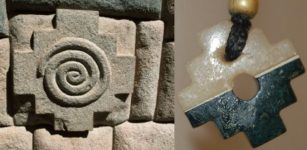 Mysterious Chakana – Sacred Inca Cross And Its Connection To The Southern Cross Constellation
Ancient Symbols | Sep 15, 2018
Mysterious Chakana – Sacred Inca Cross And Its Connection To The Southern Cross Constellation
Ancient Symbols | Sep 15, 2018 -
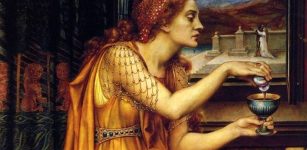 Giulia Tofana Poisoned 600 Men – Beautiful Sicilian Woman And Her Deadly Mission
Featured Stories | Feb 22, 2018
Giulia Tofana Poisoned 600 Men – Beautiful Sicilian Woman And Her Deadly Mission
Featured Stories | Feb 22, 2018 -
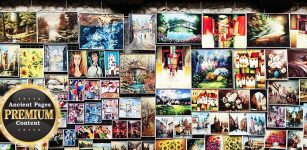 Unexplained Mystery Of A Painting That Has Been Labeled ‘Evil’
Featured Stories | Oct 3, 2018
Unexplained Mystery Of A Painting That Has Been Labeled ‘Evil’
Featured Stories | Oct 3, 2018 -
 God Dagda – A Powerful Leader Of The Tuatha De Danann In Celtic Mythology
Celtic Mythology | May 30, 2020
God Dagda – A Powerful Leader Of The Tuatha De Danann In Celtic Mythology
Celtic Mythology | May 30, 2020 -
 2,000-Year-Old Historical Tombs Unearthed In Close Vicinity To Ancient City Of Laodicea
Archaeology | Jan 23, 2020
2,000-Year-Old Historical Tombs Unearthed In Close Vicinity To Ancient City Of Laodicea
Archaeology | Jan 23, 2020 -
 1,500-Year-Old ‘Magical Mirror’ To Protect Against Evil Eye Discovered By A Teenager In Israel
Archaeology | Aug 9, 2023
1,500-Year-Old ‘Magical Mirror’ To Protect Against Evil Eye Discovered By A Teenager In Israel
Archaeology | Aug 9, 2023 -
 Unexpected And Surprising Results Of Ancient DNA Study – Who Were The First People In South America?
Archaeology | Nov 2, 2022
Unexpected And Surprising Results Of Ancient DNA Study – Who Were The First People In South America?
Archaeology | Nov 2, 2022 -
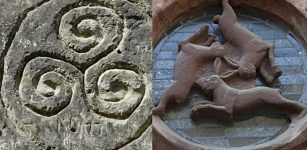 Triskelion – Millennia Old Traditional Symbol Used In Many Cultures Around The World
Ancient Symbols | Dec 13, 2018
Triskelion – Millennia Old Traditional Symbol Used In Many Cultures Around The World
Ancient Symbols | Dec 13, 2018 -
 Beowulf Is Much Older Than Previously Thought And Not An English Poem – Professor Says
Linguistic Discoveries | Jan 6, 2020
Beowulf Is Much Older Than Previously Thought And Not An English Poem – Professor Says
Linguistic Discoveries | Jan 6, 2020 -
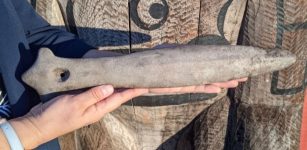 Unique Ancient Coast Salish War Club Accidently Discovered In British Columbia Backyard
Archaeology | Mar 22, 2022
Unique Ancient Coast Salish War Club Accidently Discovered In British Columbia Backyard
Archaeology | Mar 22, 2022 -
 Zoroaster’s Doomsday Prophecy About Comet Gochihr And Its Similarity With The Apocalypse Of John In The Book Of Revelation
Biblical Mysteries | Aug 17, 2017
Zoroaster’s Doomsday Prophecy About Comet Gochihr And Its Similarity With The Apocalypse Of John In The Book Of Revelation
Biblical Mysteries | Aug 17, 2017 -
 Science Unravels Some Secrets Of Mysterious Shipwreck Gribshunden
Archaeology | Sep 17, 2022
Science Unravels Some Secrets Of Mysterious Shipwreck Gribshunden
Archaeology | Sep 17, 2022 -
 On This Day In History: Macbeth, King of Scots Killed At The Battle Of Lumphanan – On August 15, 1057
News | Aug 15, 2016
On This Day In History: Macbeth, King of Scots Killed At The Battle Of Lumphanan – On August 15, 1057
News | Aug 15, 2016 -
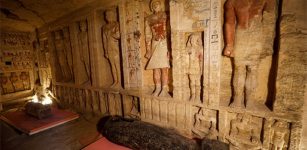 Collection Of 59 Well-Preserved 26th Dynasty Coffins Unearthed In Saqqara Necropolis, Egypt
Archaeology | Oct 4, 2020
Collection Of 59 Well-Preserved 26th Dynasty Coffins Unearthed In Saqqara Necropolis, Egypt
Archaeology | Oct 4, 2020 -
 On This Day In History: Battle Of Cibalae Was Fought Between Two Roman Emperors – On Oct 8, 314
News | Oct 8, 2016
On This Day In History: Battle Of Cibalae Was Fought Between Two Roman Emperors – On Oct 8, 314
News | Oct 8, 2016 -
 Ancient Symbol Hamsa: It’s Meaning And History Explained
Ancient Symbols | May 20, 2020
Ancient Symbol Hamsa: It’s Meaning And History Explained
Ancient Symbols | May 20, 2020 -
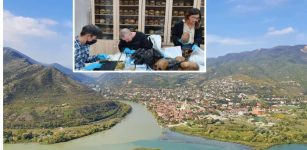 DNA Study Of 5,000 Years Of The South Caucasus’ Population: Genetic Ancestry, Mobility And Intentionally Deformed Skulls
Archaeology | Aug 8, 2025
DNA Study Of 5,000 Years Of The South Caucasus’ Population: Genetic Ancestry, Mobility And Intentionally Deformed Skulls
Archaeology | Aug 8, 2025 -
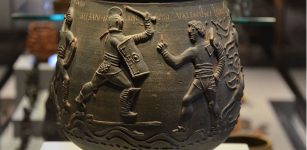 Colchester Vase Offers ‘Startling’ Evidence Of Gladiator Fights In Roman Britain
Archaeology | Mar 6, 2023
Colchester Vase Offers ‘Startling’ Evidence Of Gladiator Fights In Roman Britain
Archaeology | Mar 6, 2023 -
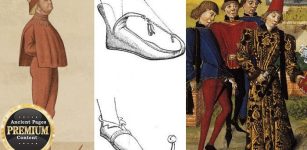 Why Were Uncomfortable Poulaines High Fashion During The Middle Ages?
Ancient History Facts | Feb 19, 2025
Why Were Uncomfortable Poulaines High Fashion During The Middle Ages?
Ancient History Facts | Feb 19, 2025

